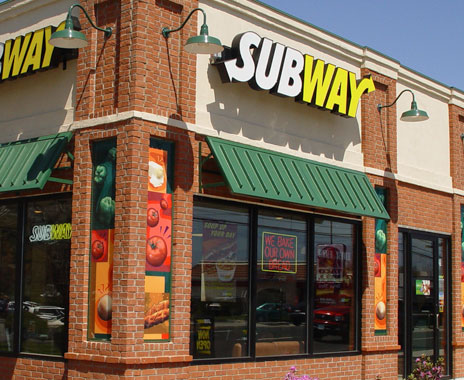Subway has its fingers, toes, and foot-longs crossed in hopes that the roots of its problems are digital.
The world’s largest sandwich chain is betting big that a top-to-bottom overhaul of its digital program—even creating an entire digital division as its own entity—will lift the chain out of a nearly two-year funk that’s allowed several regional and fast-casual competitors to gain ground. The move follows a two-year slide in sales and unit growth that has included the death of its founder, Fred DeLuca, and the public relations nightmare surrounding former spokesman Jared Fogle’s prison sentence. Last year, the company’s system-wide sales fell by $400 million from 2014, while it added just 145 net stores last year (after years of growing often by 1,000 units or more).
For Subway, the digital revolution is do or die. That’s especially true as competitors like Jersey Mike’s and Jimmy John’s nibble away at its core business, and as fast-food giants like Starbucks, Domino’s, and Taco Bell invest heavily in digital-forward plans.
By creating an entirely new digital division dubbed Subway Digital, which places all customer-related digital technology under the umbrella of a single group, Subway hopes to stop the bleeding and ultimately pull ahead in the ultra-competitive quick-service category.
“The world has changed,” says Carman Wenkoff, chief information officer and chief digital officer at Subway. “The customer experience starts outside of the restaurant now—not inside.”
Wenkoff says Subway is basically starting over digitally. “This isn’t some internal reorganization that shuffles around the deck chairs,” he says. “It’s all new. We’re putting strategy, marketing, technology, and operations people together under one digital roof with a single mission to reinvent the customer experience.”
Among Subway’s digital changes are plans to revamp existing technology. The company’s app will be seriously upgraded, though Wenkoff won’t say what those specific changes are just yet. In addition, Subway will update its loyalty program. Instead of customers simply earning points for purchases, a new program under review will customize rewards to fit each customer’s buying habits.
“No more one size fits all,” Wenkoff says. “We’ll leverage what we know about each customer to deliver individual experiences.”
Kiosks will also be a part of the digital makeover. Subway tried kiosks some years ago with little success. Even then, the company is investigating new options, “which could play an important part in our future,” Wenkoff says.
Social media and social payment channels will also be an important part. Wenkoff declines to be specific, but says there could be a Facebook tie-in. Finally, Subway will use digital as a means of transparency. With customers increasingly demanding information on the nutritionals and sourcing of foods and drinks, Subway will use digital technology to make that information “super easy to access,” Wenkoff says.
Wenkoff won’t reveal what Subway is spending on the giant digital step forward other than to note that it is “a significant investment in the future of our company.”
At least one restaurant consultant wonders if Subway is arriving late to the digital game—and overspending to catch up.
“What they are planning is no different than what is widespread throughout the industry, so whatever initiative they design and implement will not be that different than what already exists,” says Jerry McVety, president of McVety & Associates, a foodservice and hospitality consulting firm.
But Wenkoff says the Subway team doesn’t feel like they’ve fallen behind. “This is not digital for the sake of digital,” he says. “It’s about reinventing the customer experience and meeting the expectations of customers, particularly Millennials and Gen Z.”
Subway has delved into digital before. It was one of the first brands to use mobile wallet technology like Apple Pay and Android Pay. And it was relatively early in offering remote and mobile ordering. Subway also offered one of the first dual wallet gift/loyalty cards.
Now, however, the latest digital strategy represents a multi-year project that could result in new initiatives as early as 2017.
“None of our immediate competitors have hit digital out of the park yet,” Wenkoff says. “I don’t think anyone owns the category.”
But Subway hopes to. Sometime in the future, Wenkoff says, Subway may even learn to anticipate “what you like and deliver it to you by drone—before you even ask for it.”





